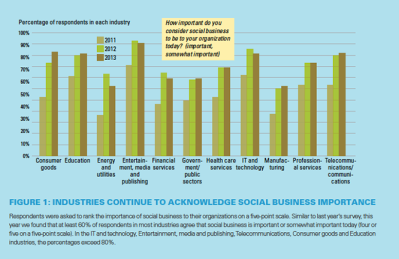
In his recent TEDx speech1, Professor Gerard Kane said, “The difference between high-mature and low-mature companies is the way they are using social data.” He then emphasized that highly mature companies see their social media as an opportunity to rethink the way they operate.
Professor Kane is one of the authors of the report Moving Beyond Marketing released July 14th by MIT Sloan Management Review2. The research study examined how different companies across multiple industries derive social business value from their activities across social media (including instant messaging, wikis, blogs, employee forums, and other social platforms that enable connections between people) and use acquired social data to transform their organizations.
MIT experts suggest that the role of social media is being redefined these days. While in the past social media was primarily used as a marketing tool, now it has other important applications. The research highlights the Red Cross as an example – the organization initially used social media in marketing and fundraising efforts, but later made it a tool for “core operational activities, including mobilizing communities and managing the logistics of its trucks and supplies.”
The study also debunked the myth that social media is mostly a B-to-C phenomenon because of its convenience for customers. According to the authors, both B-to-B and B-to-C businesses receive the same value from their social business.
Researchers pointed out that companies have started paying more attention to their social media presence over the last few years. Moreover, social media monitoring has become an important practice; more than 90% of maturing companies actively do this using a variety of methods.
 This table from the study illustrates how different industries – including consumer goods, media and telecommunications – estimated the importance of social media in the last three years.
This table from the study illustrates how different industries – including consumer goods, media and telecommunications – estimated the importance of social media in the last three years.
Companies aren’t alone in their increasing reliance on social media. About 57% of poll respondents say that a well-established social media presence of their prospective employer is at least somewhat important for them. And it’s not only “millennials” who care about a company’s Facebook and Twitter: people ranging in age from 22 to 52 want their future employer to be social-media savvy. In response to this trend, many companies encourage employees to act as brand ambassadors on their social platforms, in order to spread the word about corporate culture and work experience.
Another interesting fact that the report reveals is that U.S. and non-U.S. companies have different aspirations for the future of social media. While both categories consider social business important or somewhat important today (roughly 75% of respondents), managers outside of the U.S. see a greater potential with using social media for business and are more likely to use it in future.
In conclusion, the authors of the report provide best practices and recommendations for deriving social business value and driving companies to social maturity. Business leaders should: 1) use measurement and data to understand social business value; 2) ensure that C-Suite is aligned with social business goals and all decision makers are empowered to “work across organizational boundaries” and; 3) encourage employees to become brand ambassadors and “put their best social foot forward.”
Resources
- Social Media…You Haven’t Seen Anything Yet: https://www.youtube.com/watch?v=KzcQzM8CgIc&index=7&list=PLsRNoUx8w3rMWaFZNLL4ILjuCxlbpqbVH
- Moving Beyond Marketing: Generating Social Business Value Across the Enterprise: http://getcommandpost.com/assets/2014/07/MITSMR-Deloitte-SocialBusiness2014.pdf